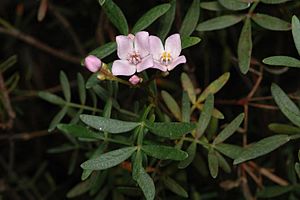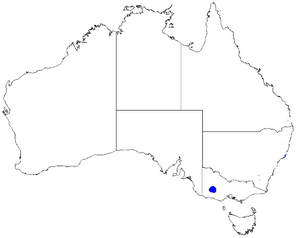Grampians boronia facts for kids
Quick facts for kids Grampians boronia |
|
|---|---|
 |
|
| Boronia latipinna in Australian National Botanic Gardens | |
| Scientific classification | |
 |
|
| Occurrence data from Australasian Virtual Herbarium |
The Grampians boronia, also known by its scientific name Boronia latipinna, is a special plant. It belongs to the citrus family, called Rutaceae. This plant is only found in one place: the beautiful Grampians National Park in Victoria, Australia. It's a woody shrub that stands upright. It has leaves made of smaller leaflets, and its flowers are usually pink or white with four petals.
Contents
What Does Grampians Boronia Look Like?
The Grampians boronia is a woody shrub that grows straight up. It can reach a height of about 2.5 metres (8 feet). Most parts of the plant are smooth and hairless, except for some parts of its flowers.
Leaves of the Plant
The leaves of this boronia are pinnate. This means each leaf is made up of several smaller leaflets, like a feather. There are usually five, seven, or nine leaflets on each leaf. The whole leaf can be between 20 and 55 millimetres (0.8 to 2.2 inches) long and wide. It sits on a stalk called a petiole, which is 6 to 18 millimetres (0.2 to 0.7 inches) long.
The leaflet at the very end of the leaf is shaped like an oval or a spear. It is 4 to 27 millimetres (0.2 to 1.1 inches) long and 2 to 8 millimetres (0.08 to 0.3 inches) wide. The leaflets on the sides are similar but often a bit longer.
Flowers of the Plant
The flowers of the Grampians boronia are either pink or white. They grow in groups, with anywhere from three to twenty-five or more flowers together. These groups appear where the leaves meet the stem, or at the ends of the branches.
Each group of flowers grows on a stalk called a peduncle, which is 5 to 13 millimetres (0.2 to 0.5 inches) long. Each individual flower also has its own small stalk, called a pedicel, which is about the same length.
The flowers have four small, triangular or egg-shaped sepals. These are like small leaves that protect the flower bud. They are about 1 to 1.5 millimetres (0.04 to 0.06 inches) long and wide. The four petals are the colourful parts of the flower, measuring 6 to 8.5 millimetres (0.2 to 0.3 inches) long. They have a few short, soft hairs. Inside the flower, there are eight stamens, which are the parts that produce pollen. These also have a few soft hairs.
Grampians boronia usually flowers from August to December.
How the Plant Got Its Name
The scientific name Boronia latipinna was first officially described in 1957. A scientist named James Hamlyn Willis wrote about it in a publication called The Victorian Naturalist. He used a plant sample collected by Herbert Bennett Williamson from the top of Mount Dulwil.
The second part of the scientific name, latipinna, comes from two Latin words. Latus means "broad" or "wide," and pinna means "leaflet." This name was chosen because the leaflets of this plant are wider compared to those of a similar plant called B. pinnata.
Where Grampians Boronia Grows
All the known groups of Grampians boronia plants are found only within the Grampians National Park. They grow in different types of areas, including forests, woodlands, and open heathlands. These plants prefer to grow in soils that come from sandstone.

